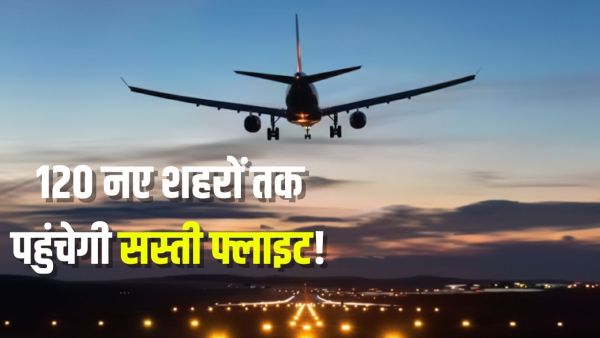
Government is gearing up for major expansion of 'UDAN' scheme
The Central Government's ambitious 'Ude Desh ka Aam Nagrik' i.e. UDAN scheme is standing on the cusp of a major change. This is the same scheme which has worked to bring small and remote cities of the country on the aerial map. Now the government wants to take this scheme forward more aggressively, but the current funding method is proving inadequate. Therefore, now the government is seriously considering many new options including giving money directly from its budget, so that air travel remains cheap and accessible for the common man.
What is the government's big plan?
The government plans to connect 120 new destinations by air in the next 10 years. Not only this, there are preparations to include helicopter and seaplane services also in this expansion. Obviously, this big goal will require big funds.
According to a senior government official, "The scheme will be expanded aggressively... According to our calculations, the existing funding mechanism will not be sufficient to make it practical. Therefore, we are examining alternative mechanisms."
Actually, under the UDAN scheme, the fare of half the seats on the routes of small cities is limited (cap), so that the common people can also travel. Due to low fares and low initial passenger numbers, these routes are not commercially profitable for airlines. To compensate for this loss, the government provides incentives to airlines, which include subsidies as well as waiver of landing and navigation fees. Now that the scope of the scheme is being expanded so much, the burden of subsidy is also sure to increase, for which the existing funds will not be enough.
Why were the big airlines hesitant?
At present, 80% of the money for this scheme comes from the levy of Rs 6,500 levied on other commercial flights operating in the country. The remaining 20% is borne by the respective state governments. But now the government does not want to burden the passengers by increasing this levy further.
This is also important because in 2022, the government had tried to increase this levy to Rs 15,000 per flight, but it had to be withdrawn after strong opposition from the airlines. Big airlines like IndiGo and Air India argued that this would increase ticket prices on their main routes, which would directly impact their passengers. They are not very keen to cross-subsidise the scheme.
Clarifying the situation, another official said, "Even while expanding the scheme, we do not want to burden the passengers by increasing the levy. Therefore, one proposal is to give direct budgetary support to the scheme." This would mean that the money would come directly from the government coffers and not as a levy from passengers.
Will the subsidy period also increase?
Apart from the funding pattern, the government is considering another important aspect of the scheme. That is the period of subsidy. Currently, under the rules, the airline that wins a route in UDAN gets three years of exclusivity on that route (ie no other airline will operate there) and subsidy. The airline has to start flights within four months of winning the route.
But a big challenge has emerged in the review of the scheme. Especially for small airlines, which play an important role in long-distance connectivity, many times they are not able to start flights on time despite getting permission. The reason for this is either unavailability of aircraft or the respective airport is not fully prepared. This delay becomes a big financial burden for them.
Therefore, the government is also considering the need to extend the existing three-year period of subsidy, so that these airlines get more time to stabilise. Obviously, if the period of subsidy increases, the government will also have to increase the size of the fund.
How has the journey been so far?
The performance of the scheme since its launch in 2016 has been mixed. The government has so far given subsidies worth more than Rs 4,300 crore to airlines and spent Rs 4,638 crore on the development and upgradation of airports. However, it is also a fact that only 60% of the original 649 routes launched under the scheme are currently operational.
Despite this, regional carriers believe that the scheme is important to improve regional connectivity and is in dire need of government support. According to Simran Singh Tiwana, CEO of regional airline Star Air, “regional air connectivity is a powerful engine of progress.” He said that when a new flight connects to a regional city, it has many positive effects. Local businesses get access to larger markets, which boosts the economy. Additionally, faster travel options also improve healthcare, educational opportunities and people's overall quality of life.
-
Big Rule Changes for Aadhaar: What Every Citizen Needs to Know Now

-
Sarkari Yojana: A Government Savings Plan That Can Build ₹70 Lakh for Your Daughter’s Future

-
PM Kisan Yojana: The PM Kisan installment will arrive in the first week of November, farmers should do this first

-
Tax Saving Tips: Can Buying a Home on Loan Help You Save on Taxes? Here’s What Experts Say

-
UCO Bank Recruitment 2025: Graduates should apply immediately, learn how the selection process will be conducted..
